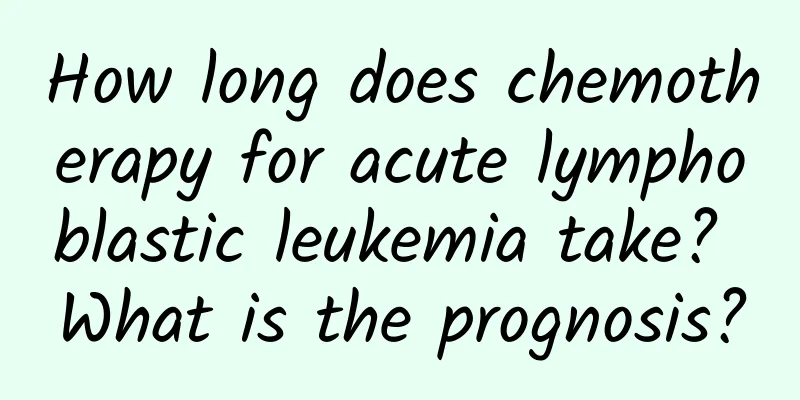How long does chemotherapy for acute lymphoblastic leukemia take? What is the prognosis?

|
Author: Yang Lihua, deputy chief physician, Zhujiang Hospital, Southern Medical University Reviewer: Luo Xuequn, Chief Physician, First Affiliated Hospital of Sun Yat-sen University Leukemia is the most common malignant tumor disease in children, with an incidence rate of 3-4/100,000, and has been on the rise in recent years. Today, let's learn about childhood leukemia. Q. How does leukemia occur? First, let's look at the origin of leukemia. The proliferation and renewal of normal cells in the human body is actually the process of gene replication. If our genes replicate normally, we can get cells with normal functions, which are passed down from generation to generation. The end of the service life of cells is death, but there will be a next generation of cells to take over, supplemented by human stem cells to maintain cell stability. This is the normal renewal process of the body. However, everyone may be affected by internal and external factors, which may lead to genetic mutations. For example, some individuals have some susceptible genes, which is an internal factor; in addition, some individuals have a higher probability of being exposed to toxic and radioactive substances, which is an external factor. But we should not be anxious about this. Not every gene mutation results in cancer, nor does exposure to toxic or radioactive substances lead to cancer. When the body faces a gene mutation, it will first repair it, and abnormal cells that cannot be repaired will undergo apoptosis. But there are also unfortunate situations, where the mutation may cause the apoptosis rate to fail to keep up with the abnormal proliferation rate of cells, thus forming a tumor. Just like leukemia, it evades the body's checkpoints, competes with the human body for nutrients, makes people become thin, and easily leads to cachexia. The occurrence of leukemia shows that tumors have their own strict system. Figure 1 Copyright image, no permission to reprint Q. What is leukemia? Aren’t stomach cancer, intestinal cancer, brain tumor, etc. called “cancer” or “tumor”? Why doesn’t leukemia use the word “disease” instead of “cancer” or “tumor”? The name of leukemia mainly comes from the fact that the blood drawn from patients was white when it was first discovered in 1847. Therefore, the disease was named leukemia. Later, with the deepening of cognition, people found that it was a cancer, but the name leukemia was retained and used. Q. How to detect leukemia early? As we all know, the earlier a malignant tumor is discovered and treated, the easier it is to recover. Therefore, to detect whether a child has leukemia early, it is necessary to observe carefully every day. If a child has the following 9 early symptoms, parents should be careful and take the child to see a doctor in time so that the doctor can make a scientific judgment. 1. Fever : It is the most common symptom. If the high fever persists and keeps coming back after using antibiotics and anti-inflammatory drugs, you should be alert and check your blood routine as soon as possible. 2. Recurrent infections : Recurrent respiratory and digestive tract infections. 3. Fatigue : The child feels listless, cannot run, needs to be carried when going up the stairs, and falls asleep as soon as he gets home. 4. Pale complexion : Pale or yellowish complexion, without luster. 5. Difficulty breathing : feeling like you can’t breathe, as if something is pressing on you. 6. Bone pain : such as knee pain and ankle pain, it is easy to be mistaken for rheumatism and treated as such. 7. Unexplained bleeding on the skin : There are bleeding spots and bruises on the skin. 8. Bleeding from the gums or nose . 9. Others : Stomach distension (liver and spleen enlargement), children often do not feel pain, but just can't eat, so when changing clothes for children, if you see that their stomach is swollen and hard, be sure to see a doctor in time. In addition, if you find bulging bags on the neck and armpits of children, be careful. If the child has testicular enlargement, that is, scrotal enlargement, discoloration and hardening, etc., pay attention to observe when changing clothes or bathing. If the child has dizziness, cramps, limb movement disorders, etc., you also need to be careful. Figure 2 Copyright image, no permission to reprint Q. Why do these symptoms occur? From the picture below, we can see that the bone marrow in the bones is full of various blood cells. The characteristic of cancer is that it proliferates very quickly and can escape the "hunt" of the immune system, but grows wildly, using quantity to buy time, competing for the space of normal cells, occupying the bone marrow cavity, and seizing nutrients. Figure 3 Copyright image, no permission to reprint Therefore, normal hematopoietic cells have no space and no nutrition, and are thus inhibited. Then, if there are too few white blood cells, there will be infection, if there are too few platelets, there will be bleeding, and if there are too few red blood cells, there will be anemia. Q. If leukemia is suspected, what tests should be done? Are these tests necessary? When leukemia is suspected, the first thing to do is to check the blood routine to see if the blood cell count is within the normal range. If conditions permit, a smear can be made to observe the morphology of the cells under a microscope to see if they are normal. Then a bone marrow puncture should be done as soon as possible. Bone marrow puncture will be performed with anesthesia and a very fine needle. In addition, it is necessary to examine the origin of the leukemia. Therefore, flow cytometry, chromosome, and gene testing, lumbar puncture, lymph node biopsy, CT, ultrasound, magnetic resonance imaging, etc. are required to determine the range of leukemia infiltration lesions or the site of invasion. Figure 4 Copyright image, no permission to reprint Q. What are the types of leukemia? Can we know the type of leukemia after the examination? In fact, leukemia can be divided into acute and chronic types. Acute, the disease progresses quickly. Chronic, may not endanger life for more than ten years. Acute leukemia is mainly divided into lymphoid and myeloid systems based on the classification of bone marrow cells. Childhood leukemia is mainly acute lymphocytic leukemia (ALL), accounting for about 75%. Acute myeloid leukemia is mainly seen in young and middle-aged people. Chronic lymphocytic leukemia mainly occurs in the elderly. Figure 5 Copyright image, no permission to reprint Q. Do I need daily injections to treat leukemia? With the advancement of technology, now with PICC tubes, children no longer need to be injected again and again. PICC tubes and infusion ports can directly lead to the heart, and the benefits are: The chemotherapy drugs that pass through the tube no longer come into contact with the blood vessels, thus avoiding the vascular damage caused by the chemotherapy drugs. Medication can be administered directly through the indwelling tube, eliminating the need for injections every time and sparing the child pain. Chemotherapy drugs go directly to the heart, and when the heart pumps blood, the drugs are quickly spread throughout the body through the blood, preventing the drugs from gathering in a local area and damaging the body's organs. Figure 6 Copyrighted images are not authorized for reproduction Q. What are the methods for treating leukemia? After learning so much about leukemia, the ultimate goal is to cure it. So what are the methods for treating leukemia? They mainly include the five treatment methods shown in the figure below. Figure 7 Copyright image is not authorized for reproduction Infusion and medication are chemotherapy. Currently, chemotherapy is the main treatment for acute lymphoblastic leukemia (ALL). Eighty to ninety percent of children can be cured by chemotherapy. However, for some difficult-to-treat children, immunotherapy and targeted therapy will be used as supplementary and enhanced treatment. In addition, for those that invade local areas, such as the central nervous system and testicles, radiotherapy can be used for local treatment. In addition, for about 10% of patients, if the treatment effect is not good and it is really impossible to cure, hematopoietic stem cell transplantation will be used as a rescue treatment. Q. How long does chemotherapy for acute lymphoblastic leukemia take? Usually, the chemotherapy treatment cycle for acute lymphoblastic leukemia takes 2 to 3 years, but hospitalization is not required for 2 to 3 years. The actual hospitalization time is about half a year, and most of the other time is spent at home for maintenance treatment and regular return to the hospital for checkups. Induction, consolidation, re-induction and maintenance are carried out in stages. The initial induction is about 1 month, consolidation 1 to 2 months, and re-induction for about 2 months, and then maintenance. From the figure below we can see that leukemia cells proliferate rapidly, but this characteristic is also the reason why chemotherapy drugs can kill them. Damaged leukemia cells will not recover too quickly in a short period of time, but the body's rapidly proliferating normal cells recover particularly quickly after being damaged by chemotherapy drugs. This gives us the opportunity to gradually eliminate tumors step by step. Figure 8 Copyright image, no permission to reprint Q. Can the dosage of chemotherapy drugs and/or the number of chemotherapy treatments for leukemia be reduced? In order to prevent and overcome drug resistance as much as possible, chemotherapy for leukemia requires a combination of multiple drugs and a certain dosage intensity. If the drug dose is too low or the chemotherapy interval is too long, the leukemia cells cannot be killed and will induce drug resistance in the leukemia cells. In other words, if the enemy cannot be killed, it will become stronger. Figure 9 Copyright image, no permission to reprint Q. Why do patients with acute lymphoblastic leukemia have to receive maintenance treatment for about 2 years? During maintenance treatment, there is still a certain number of residual leukemia cells in the patient's body. The purpose of maintenance treatment with small doses of chemotherapy drugs is to prevent the residual leukemia cells from rebounding, gradually restore immune function, and then rely on the patient's own immune cells to completely eliminate the residual leukemia cells. Figure 10 Copyright image, no permission to reprint Q. What is the prognosis of acute lymphoblastic leukemia? You must believe that acute lymphoblastic leukemia is a completely curable disease. Currently, advanced treatment centers around the world have achieved a cure rate of over 90%, so everyone can maintain sufficient confidence. Finally, it is worth mentioning that chemotherapy does not affect the reproductive function of children and will not be passed on to the next generation. |
<<: Doctor, why does my child's new glasses feel uncomfortable to wear?
>>: Financial report: Zynga accounts for 15% of Facebook's quarterly revenue
Recommend
What can I add to make sesame paste thinner? What can I add to make sesame paste not go bad?
As we all know, sesame paste is a common sauce. I...
What disinfectant is good for the new coronavirus? Disinfection methods to prevent the new coronavirus
We all know that the new coronavirus is a highly ...
After making love, it's burning hot down there
Sex is a long-lasting human emotion. Sex itself i...
Nursing of uterine recovery after cesarean section
Cesarean section is different from natural birth,...
How long does abdominal pain last after miscarriage?
There will be abdominal pain after a natural misc...
Can pregnant women have acupuncture for headaches?
During pregnancy, women often experience some dis...
How to deal with a sprain? You need to know these 4 points as soon as possible!
In life, we may suffer sprains due to strenuous e...
What to do if your menstrual period is dark and the amount is small
Menstruation is a special period for women, and t...
What is the four-dimensional examination for pregnant women?
When a woman is pregnant, it is the best time in ...
What is Jerusalem artichoke? How to eat Jerusalem artichoke
Jerusalem artichokes generally refer to Jerusalem...
Six tips for women to protect their liver
The excessive liver fire in the body is mostly ca...
If you are losing weight, please keep this good news
Audit expert: Wu Xi Deputy Chief Physician, Depar...
Cervical erosion is not a disease
I believe that most female friends will be troubl...
The secret to longevity between 60 and 69 years old
Scholars have found that the elderly aged 60-69 h...









